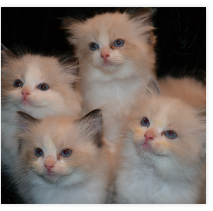



General Description
The Ragdoll is a large, affectionate, semi-longhaired cat with captivating blue eyes. One of the largest breeds in the cat fancy, the Ragdoll gets along well with children and other pets, including dogs, often living up to its name as it gets carried around the house in a child's arms. These sturdy cats have no extreme features and blend easily in to the busy modern household.
History
Ann Baker of Riverside, California developed the Ragdoll breed in the early 1960s. A pure white longhaired cat named Josephine is believed to be the matriarch of the breed along with a seal mitted male named Daddy Warbucks and a solid black cat named Blackie. Daddy Warbucks was bred to a daughter of Josephine named Buckwheat and her half-sister, Fugianna. These cats are the foundation of the Ragdoll breed. Ann insisted Josephine's genes were altered at a nearby medical center where she was taken after being hit by a car. Litters born after her return from the hospital had the limp, loving personalities Ragdolls are known for, unlike her "normal" kittens born prior to her hospitalization. Baker's breeding program consisted of a handful of breeders contracted as franchises under her. As time went on, Baker became more eccentric and breeders broke away from her so they could continue to develop the highly affectionate and consistently patterned cats. Denny & Laura Dayton were among the breeders who distanced themselves from Baker and went on to play a major role in making the Ragdoll into a legitimate breed recognized by all the major registries.
Personality
The Ragdoll is a relaxed, happy cat and, like a child's rag doll, many of these cats will go limp in your arms and flop like a stuffed doll when cuddled. Generally, the Ragdoll cat is a loving, quiet cat with a very laid back disposition. If you are looking for a very active cat or a talkative cat, a Ragdoll probably is not the breed for you, although kittens and young adults can be very rambunctious and most Ragdolls are always willing to play. Ragdolls are known for their tolerant attitudes with other animals and especially children and many will allow themselves to be dressed in doll clothes and carried around by youngsters with absolutely no resistance. They are often compared to dogs because of their friendliness and intelligence and have even been taught to play fetch.
Traits
The Ragdoll's medium length, silky coat has a soft rabbit-like texture. There is little shedding of the coat except in the spring and fall. Its soft texture means it stays on top of surfaces and is easy to pick-up with a hand or damp cloth. All pointed Ragdolls have beautiful blue eyes and come in 3 patterns: colorpoint, bicolor, mitted. The Ragdoll color pallet consists of seal, blue, chocolate, lilac, cinnamon, fawn, red and cream along with the tortoiseshell and lynx (or tabby) variations. Colorpoint Ragdolls have classic markings like the Siamese with no white anywhere on the body; mitted Ragdolls have white feet in the front looking like mittens and white to the hock on the back legs looking like boots along with a possible white blaze on the face; bi-color Ragdolls have more white extending higher up the legs than on the mitteds, splashes of white on the back, a white underside and an inverted white V on the face.
The Ragdoll is one of the largest of the cat breeds and takes up to 4 years to reach full maturity. Fully developed males weigh from 15-20 pounds with the proportionately smaller females weigh from 10-15 pounds. These gentle cats have long, substantial bodies with sturdy boning to match. They have a sweet expression emphasized by the large eyes full of love and devotion. Their features are composed of soft curves and transitions with nothing extreme or exaggerated.
The Ragdoll's plush, silky coat requires little routine grooming, although it should be brushed or combed weekly with a steel comb to remove dead hair from their coats and separate any tangles. During shedding season, be sure to watch for some tangles under the armpits.
Source: TICA
